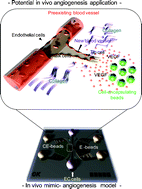In vitro angiogenesis assay for the study of cell-encapsulation therapy†
Abstract
Cell encapsulation within alginate beads has potential as a sustained release system for delivering therapeutic agents in vivo while protecting encapsulated cells from the immune system. There is, however, no in vitro model for cell-encapsulation therapy that provides a suitable platform for quantitative assessment of physiological responses to secreted factors. Here we introduce a new microfluidic system specifically designed to evaluate and quantify the pro-angiogenic potential of factors secreted from human fetal lung fibroblasts encapsulated in beads on an intact endothelial cell monolayer. We confirmed that cell-encapsulating beads induced an angiogenic response in vitro, demonstrated by a strong correlation between the encapsulated cell density in the beads and the length of the vascular lumen formed in vitro. Conditions established by in vitro tests were then further shown to exert a pro-angiogenic response in vivo using a subcutaneous mouse model, forming an extensive network of functional luminal structures perfused with red blood cells.


 Please wait while we load your content...
Please wait while we load your content...